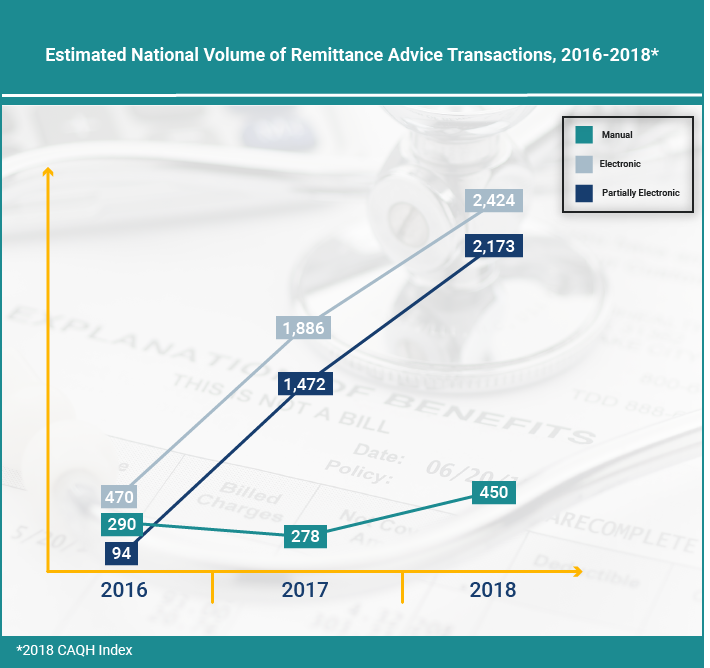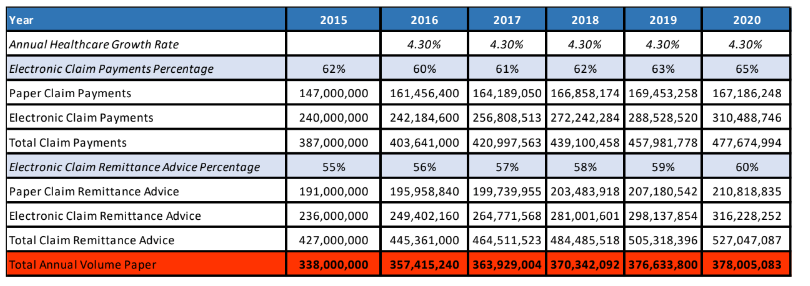OrboGraph Projects Growth of PDF and Paper Volumes for RCM
Today’s focus is on the remittance advice and payments. The first data point of interest: Remittance Advice Volumes are increasing. (Source: CAQH)
On a positive note, the industry growth in overall transactions and remits on the back end is healthy! CMS alone paid $390 billion in claims in 2017. That leaves another 40-60% of the revenues coming from private and 3rd party payers for providers; much of which is delivered as paper or PDF.
The Reality of Paper
CAQH (Council for Affordable Quality Healthcare) released their surprising 2018 findings around healthcare’s adoption of electronic transactions.
When dealing with remittance advices, native EDI 835 utilization decreased:
- Electronic EDI 835 utilization dropped from 56% to 48% between 2017 and 2018.
- Use of “partially electronic” ERA methods (i.e., payer portals, PDF utilization) increased from 36% to 43% while fully manual and fully electronic adoption increased slightly and even decreased, respectively.
However, payments continue to slowly progress from check to ACH:
- Electronic claim payments have increased
- 60% to 63% for medical providers (from check to ACH)
- 9% to 12% for dental (starting from ground zero)
- 11.5% increase in ACH (we saw $306.7 million EFT payments in 2018)
Overall, the volume of remittance advice transactions has increased with paper volumes of EOB/EOP/correspondence letters increasing along with it — meaning providers will see an increase in processing costs. In turn, without the right technology, RCM companies will need to increase staffing to handle the manual processing load.
OrboGraph Projections
We also wanted to see for ourselves...
OrboGraph conducted a study by estimating transaction volumes and focusing on a range of aggregator volumes. These results won’t necessarily sync with overall industry numbers, but what we found was startling from our estimates.
The Highlights:
Despite increases in electronic payment and remit activity, we’re still seeing paper & PDF volumes jumping:
- Paper Claim Remittance Advices (EOB/EOP) increased from 203M to 210M
- Check payments finally decline in 2020, but still are estimated at 167M
With a “long tail” of check and EOB utilization, we have identified a situation where overall, non-electronic payments and remits increase!
These manual processes are expensive, with remittance advance transaction costs ranging between $3 and $5 for providers, billers, and clearinghouses — even for rev cycle providers who offshore.
Why RCM Servicers Should Pay Attention to Paper
The unique dynamics of today’s revenue cycle environment mean RCM servicers have an opportunity to see distinct benefits by addressing paper challenges head-on.
- Avoiding deceptive inertia: Smart revenue cycle strategies start with accepting the reality of paper in the modern revenue cycle and converting to electronic via imaging technology.
- Creating a strategy that’s prepared for the future of revenue cycle: Future-ready revenue cycle strategies should be employed to enable non-electronic payments, remits, and supporting documentation requests.
- And updated tech stack: Your technology choices should leverage AI to streamline costs and drive competitive advantage. BPOs and RCM entities who haven’t accepted the realities of the modern rev cycle are using outdated platforms for manual data entry and processing — and they’re going to be left behind.
Adopting a strategic vision that takes a realistic stance on automating paper-centric processes is the key to survival and success in today’s revenue cycle.
What's the Answer?
Yesterday’s answer would have been hiring more staff to address the growth in paper volumes, but today, paper challenges like this are an outstanding use case for applying artificial intelligence (AI).
We’ve talked about AI’s application in image processing and data extraction, and modernizing revenue cycle platforms, but it’s also an incredibly powerful tool in turning the increasing volumes of paper into a strategic asset that can actually differentiate your organization. Learn more about that in this white paper.
Bonus Content from Previous Blog Posts:
Sign Up for Blog Notifications
Previous Blog Posts
- Enabling Hybrid Electronification in Healthcare Payments
- White Paper - Healthcare's "New" Strategic Assets: Explanation of Benefits Forms (EOBs/EOPs) and Correspondence Letters
- Modernizing with AI Solutions That Deliver RCM Electronification
- How Billing and Collections Are Revolutionized by AI
- 3 Powerful Applications of AI in RCM Today

